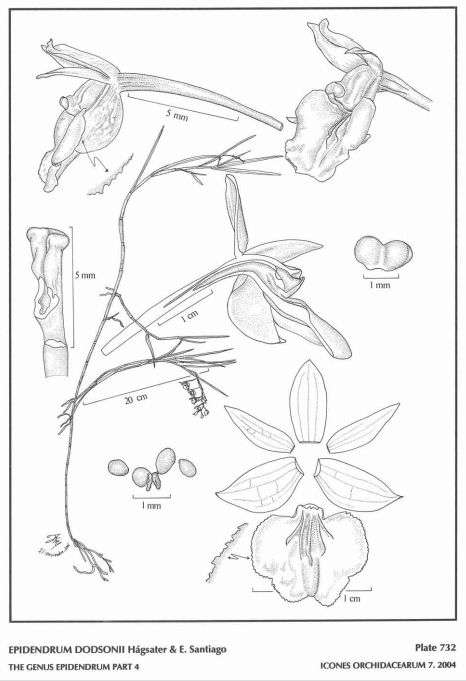

Epidendrum dodsonii Hágsater & E.Santiago 2004 GROUP Diothonea SUBGROUP Diothonea
TYPE Drawing by © Jimenez, Hágsater & E.Santiago and The AMO Herbario Website

 LATER
LATER  EARLIER
EARLIER 
Common Name or Meaning Dodson's Epidendrum [American Orchid botanist in Ecuador, current]
Flower Size .8" [2 cm]
Found in northern Ecuador on small trees on very steep hillsides at elevations around 1900 to 2600 meters as a large sized, cold growing epiphyte with branching, cane-like, terete, thin stems carrying 7 to 8, towards the apex of the stem, narrowly linear-lanceolate, unequally bilobed, apiculate leaves that blooms in the later summer and earlier fall on a terminal, occuring only once, racemose, somewhat arching, 2 to 2.8" [5 to 7 cm] long including the short peduncle, laxly, successively 4 at once, to 19 flowered inflorescence with much shorter than the ovary triangular, acute floral bracts and carrying light brown to cream colored flowers.
"Epidendrum dodsonii belongs to the GROUP Diothonea SUBGROUP Diothonea which is characterized by the branching plants, linear lanceolate to oblong, bilobed leaves, racemose, arching-nutant inflorescence, membranaceous flowers (rarely fleshy), the entire to 3-lobed, ecallose lip with the margin erose with or without 1 to 10 thin, smooth to erose keels, the column completely to obliquely united to the lip, the anther reniform. The new species is recognized by the thin stems, linear-lanceolate leaves less than .2" [5 mm] wide, successive flowers on a 2 to 2.8" [5 to 7 cm] long inflorescence, sepals .28 to .304" [7.0 to 7.6 mm] long, petals narrowly ovate with entire margin, and the lip united to the arched column provided with 5 keels. It keys out next to Epidendrum dolichorhachis Hágsater & Dodson, which has thicker stems, wider leaves .16 to .48" [4 to 12 mm], simultaneous, larger flowers with sepals .32 to .48" [8 to 12 mm], oblong petals, the keels of the lip are erose, the column forms a short arch at the base and then the upturned apex makes it sigmoid dorsally. Epidendrum trachysepalum from Peru, also has thin stems and narrow long leaves, but it has a short 1" [2.5 cm] inflorescence, simultaneous flowers, .38 to .44" [9.5 to 11 mm] long sepals, strongly uncinate dorsally, petals linear to linear-lanceolate, the margin minutely erose and the lip united obliquely to the column and forming a prominent sac at the base. Epidendrum cochabambanum Dodson & Vásquez known from Bolivia, Peru, Ecuador and Colombia, has still narrower, long leaves to .1" [2.5 mm] wide, a short inflorescence .8 to 1.4 [2 to 3.5 cm], dorsally granulose sepals, linear-elliptic petals, the union of the column and the entlre lip form a sac, and the column is provided with a pair of square corners near the base of the sides that unite it to the lip. Epidendrum microdiothoneum Hágsater & Dodson has much shorter leaves, to 2.2" [to 5.5 cm], a glomerulose inflorescence, with simultaneous, small flowers with a strong odor of fresh pears, the ovary inflated ventrally along 2/3 of its length, elliptic petals and the lip united obliquely to the arched column." Hagsater etal 2004
Synonyms
References W3 Tropicos, Kew Monocot list , IPNI ; * Icones Orchidacearum 7 Plate 732 Hagsater & Sanchez 2004 drawing fide; Icones Orchidacearum 7 Plate 797 Hagsater and Sanchez 2004 see recognition section; Orquideologia vol 24 #1 2005; Icones Orchidacearum 17(2) Plate 1759 Hagsater & Jimenez 2020 see recognition section;
--------------------------------------------------------------------------------------------------------------------------